Ancient Rome › Inca Civilization » Ancient origins
Articles and Definitions › Contents
- Ancient Rome › Ancient History
- Inca Civilization › Antique Origins
Ancient civilizations › Historical and archaeological sites
Ancient Rome › Ancient History
Definition and Origins
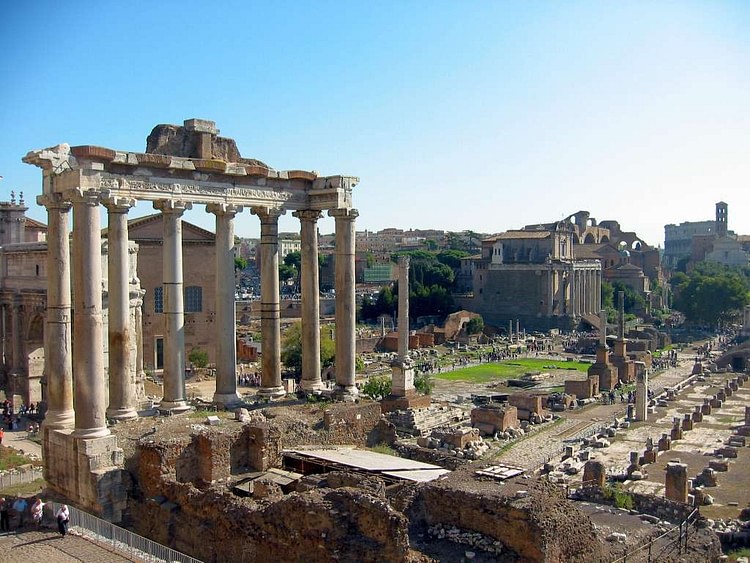
According to legend, Ancient Rome was founded by the two brothers, and demi-gods, Romulus and Remus, on 21 April 753 BCE. The legend claims that, in an argument over who would rule the city (or, in another version, where the city would be located) Romulus killed Remus and named the city after himself. This story of the founding of Rome is the best known but it is not the only one.
Other legends claim the city was named after a woman, Roma, who traveled with Aeneas and the other survivors from Troyafter that city fell. Upon landing on the banks of the Tiber River, Roma and the other women objected when the men wanted to move on. She led the women in the burning of the Trojan ships and so effectively stranded the Trojan survivors at the site which would eventually become Rome. Aeneas of Troy is featured in this legend and also, famously, in Virgil 's Aeneid, as a founder of Rome and the ancestor of Romulus and Remus, thus linking Rome with the grandeur and might which was once Troy.
Still other theories concerning the name of the famous city suggest it came from Rumon, the ancient name for the Tiber River, and was simply a place-name given to the small trading centre established on its banks or that the name derived from an Etruscan word which could have designated one of their settlements.
EARLY ROME
Originally a small town on the banks of the Tiber, Rome grew in size and strength, early on, through trade. The location of the city provided merchants with an easily navigable waterway on which to traffic their goods. The city was ruled by seven kings, from Romulus to Tarquin, as it grew in size and power. Greek culture and civilization, which came to Rome via Greek colonies to the south, provided the early Romans with a model on which to build their own culture. From the Greeks they borrowed literacy and religion as well as the fundamentals of architecture.
The Etruscans, to the north, provided a model for trade and urban luxury. Etruria was also well situated for trade and the early Romans either learned the skills of trade from Etruscan example or were taught directly by the Etruscans who made incursions into the area around Rome sometime between 650 and 600 BCE (although their influence was felt much earlier).The extent of the role the Etruscans played in the development of Roman culture and society is debated but there seems little doubt they had a significant impact at an early stage.
From the start, the Romans showed a talent for borrowing and improving upon the skills and concepts of other cultures. The Kingdom of Rome grew rapidly from a trading town to a prosperous city between the 8th and 6th centuries BCE. When the last of the seven kings of Rome, Tarquin the Proud, was deposed in 509 BCE, his rival for power, Lucius Junius Brutus, reformed the system of government and established the Roman Republic.
IT WAS WAR WHICH WOULD MAKE ROME A POWERFUL FORCE IN THE ANCIENT WORLD.
WAR & EXPANSION
Though Rome owed its prosperity to trade in the early years, it was war which would make the city a powerful force in the ancient world. The wars with the North African city of Carthage (known as the Punic Wars, 264-146 BCE) consolidated Rome's power and helped the city grow in wealth and prestige. Rome and Carthage were rivals in trade in the Western Mediterranean and, with Carthage defeated, Rome held almost absolute dominance over the region; though there were still incursions by pirates which prevented complete Roman control of the sea.
As the Republic of Rome grew in power and prestige, the city of Rome began to suffer from the effects of corruption, greed and the over-reliance on foreign slave labor. Gangs of unemployed Romans, put out of work by the influx of slaves brought in through territorial conquests, hired themselves out as thugs to do the bidding of whatever wealthy Senator would pay them.The wealthy elite of the city, the Patricians, became ever richer at the expense of the working lower class, the Plebeians.
In the 2nd century BCE, the Gracchi brothers, Tiberius and Gaius, two Roman tribunes, led a movement for land reform and political reform in general. Though the brothers were both killed in this cause, their efforts did spur legislative reforms and the rampant corruption of the Senate was curtailed (or, at least, the Senators became more discreet in their corrupt activities). By the time of the First Triumvirate, both the city and the Republic of Rome were in full flourish.

The Lost Gods: The Romans (Planet Knowledge)
THE REPUBLIC
Even so, Rome found itself divided across class lines. The ruling class called themselves Optimates (the best men) while the lower classes, or those who sympathized with them, were known as the Populares (the people). These names were applied simply to those who held a certain political ideology; they were not strict political parties nor were all of the ruling class Optimates nor all of the lower classes Populares.
In general, the Optimates held with traditional political and social values which favored the power of the Senate of Rome and the prestige and superiority of the ruling class. The Populares, again generally speaking, favored reform and democratization of the Roman Republic. These opposing ideologies would famously clash in the form of three men who would, unwittingly, bring about the end of the Roman Republic.
Marcus Licinius Crassus and his political rival, Gnaeus Pompeius Magnus ( Pompey the Great ) joined with another, younger, politician, Gaius Julius Caesar, to form what modern historians call the First Triumvirate of Rome (though the Romans of the time never used that term, nor did the three men who comprised the triumvirate). Crassus and Pompey both held the Optimate political line while Caesar was a Populare.
The three men were equally ambitious and, vying for power, were able to keep each other in check while helping to make Rome prosper. Crassus was the richest man in Rome and was corrupt to the point of forcing wealthy citizens to pay him `safety' money. If the citizen paid, Crassus would not burn down that person's house but, if no money was forthcoming, the fire would be lighted and Crassus would then charge a fee to send men to put the fire out. Although the motive behind the origin of these fire brigades was far from noble, Crassus did effectively create the first fire department which would, later, prove of great value to the city.
Both Pompey and Caesar were great generals who, through their respective conquests, made Rome wealthy. Though the richest man in Rome (and, it has been argued, the richest in all of Roman history) Crassus longed for the same respect people accorded Pompey and Caesar for their military successes. In 53 BCE he lead a sizeable force against the Parthians at Carrhae, in modern day Turkey, where he was killed when truce negotiations broke down.
With Crassus gone, the First Triumvirate disintegrated and Pompey and Caesar declared war on each other. Pompey tried to eliminate his rival through legal means and had the Senate order Caesar to Rome to stand trial on assorted charges. Instead of returning to the city in humility to face these charges, Caesar crossed the Rubicon River with his army in 49 BCE and entered Rome at the head of it.
He refused to answer the charges and directed his focus toward eliminating Pompey as a rival. Pompey and Caesar met in battle at Pharsalus in Greece in 48 BCE where Caesar's numerically inferior force defeated Pompey's greater one. Pompey himself fled to Egypt, expecting to find sanctuary there, but was assassinated upon his arrival. News of Caesar's great victory against overwhelming numbers at Pharsalus had spread quickly and many former friends and allies of Pompey swiftly sided with Caesar, believing he was favored by the gods.
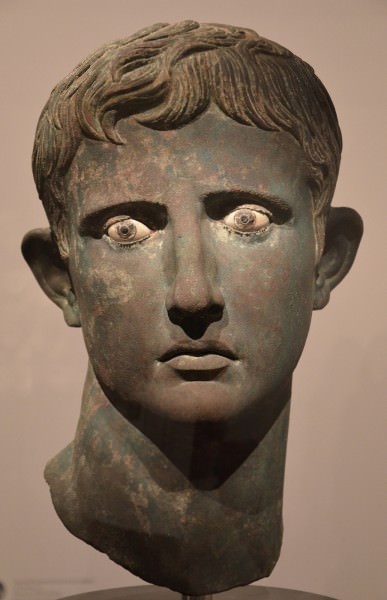
Bronze Head of Augustus
TOWARDS EMPIRE
Julius Caesar was now the most powerful man in Rome. He effectively ended the period of the Republic by having the Senate proclaim him dictator. His popularity among the people was enormous and his efforts to create a strong and stable central government meant increased prosperity for the city of Rome. He was assassinated by a group of Roman Senators in 44 BCE, however, precisely because of these achievements.
The conspirators, Brutus and Cassius among them, seemed to fear that Caesar was becoming too powerful and that he might eventually abolish the Senate. Following his death, his right-hand man, and cousin, Marcus Antonius ( Mark Antony ) joined forces with Caesar's nephew and heir, Gaius Octavius Thurinus ( Octavian ) and Caesar's friend, Marcus Aemilius Lepidus, to defeat the forces of Brutus and Cassius at the Battle of Phillippi in 42 BCE.
Octavian, Antony and Lepidus formed the Second Triumvirate of Rome but, as with the first, these men were also equally ambitious. Lepidus was effectively neutralized when Antony and Octavian agreed that he should have Hispania and Africa to rule over and thereby kept him from any power play in Rome. It was agreed that Octavian would rule Roman lands in the west and Antony in the east.
Antony's involvement with the Egyptian queen Cleopatra VII, however, upset the balance Octavian had hoped to maintain and the two went to war. Antony and Cleopatra 's combined forces were defeated at the Battle of Actium in 31 BCE and both later took their own lives. Octavian emerged as the sole power in Rome. In 27 BCE he was granted extraordinary powers by the Senate and took the name of Augustus, the first Emperor of Rome. Historians are in agreement that this is the point at which the history of Rome ends and the history of the Roman Empire begins.
MAP
Inca Civilization › Antique Origins
Definition and Origins
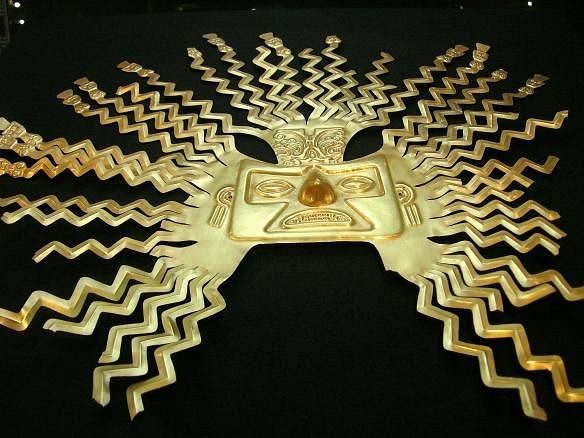
The Inca civilization flourished in ancient Peru between c. 1400 and 1533 CE, and their empire eventually extended across western South America from Quito in the north to Santiago in the south, making it the largest empire ever seen in the Americas and the largest in the world at that time. Undaunted by the often harsh Andean environment, the Incas conquered people and exploited landscapes in such diverse settings as plains, mountains, deserts, and tropical jungle. Famed for their unique art and architecture, they constructed finely-built and imposing buildings wherever they conquered, and their spectacular adaptation of natural landscapes with terracing, highways, and mountaintop settlements continues to impress modern visitors at such world famous sites as Machu Picchu.
HISTORICAL OVERVIEW
As with other ancient Americas cultures, the historical origins of the Incas are difficult to disentangle from the founding myths they themselves created. According to legend, in the beginning, the creator god Viracocha came out of the Pacific Ocean, and when he arrived at Lake Titicaca, he created the sun and all ethnic groups. These first people were buried by the god and only later did they emerge from springs and rocks (sacred pacarinas ) back into the world. The Incas, specifically, were brought into existence at Tiwanaku (Tiahuanaco) from the sun god Inti, hence, they regarded themselves as the chosen few, the 'Children of the Sun', and the Inca ruler was Inti's representative and embodiment on earth. In another version of the creation myth, the first Incas came from a sacred cave known as Tampu T'oqo or 'The House of Windows', which was located at Pacariqtambo, the 'Inn of Dawn', south of Cuzco. The first pair of humans were Manco Capac (or Manqo Qhapaq) and his sister (also his wife) Mama Oqllu (or Ocllo). Three more brother-sister siblings were born, and the group set off together to found their civilization. Defeating the Chanca people with the help of stone warriors ( pururaucas ), the first Incas finally settled in the Valley of Cuzco and Manco Capac, throwing a golden rod into the ground, established what would become the Inca capital, Cuzco.
40,000 INCAS GOVERNED A TERRITORY WITH 10 MILLION SUBJECTS SPEAKING OVER 30 DIFFERENT LANGUAGES.
More concrete archaeological evidence has revealed that the first settlements in the Cuzco Valley actually date to 4500 BCE when hunter-gather communities occupied the area. However, Cuzco only became a significant centre sometime at the beginning of the Late Intermediate Period (1000-1400 CE). A process of regional unification began from the late 14th century CE, and from the early 15th century CE, with the arrival of the first great Inca leader Pachacuti Inca Yupanqui ('Reverser of the World') and the defeat of the Chanca in 1438 CE, the Incas began to expand in search of plunder and production resources, first to the south and then in all directions. They eventually built an empire which stretched across the Andes, conquering such peoples as the Lupaka, Colla, Chimor, and Wanka civilizations along the way. Once established, a nationwide system of tax and administration was instigated which consolidated the power of Cuzco.
The rise of the Inca Empire was spectacularly quick. First, all speakers of the Inca language Quechua (or Runasimi ) were given privileged status, and this noble class then dominated all the important roles within the empire. Thupa Inca Yupanqui (also known as Topa Inca), Pachacuti 's successor from 1471 CE, is credited with having expanded the empire by a massive 4,000 km (2,500 miles). The Incas themselves called their empire Tawantinsuyo (or Tahuantinsuyu ) meaning 'Land of the Four Quarters' or 'The Four Parts Together'. Cuzco was considered the navel of the world, and radiating out were highways and sacred sighting lines ( ceques ) to each quarter: Chinchaysuyu (north), Antisuyu (east), Collasuyu (south), and Cuntisuyu(west). Spreading across ancient Ecuador, Peru, northern Chile, Bolivia, upland Argentina, and southern Colombia and stretching 5,500 km (3,400 miles) north to south, 40,000 Incas governed a huge territory with some 10 million subjects speaking over 30 different languages.
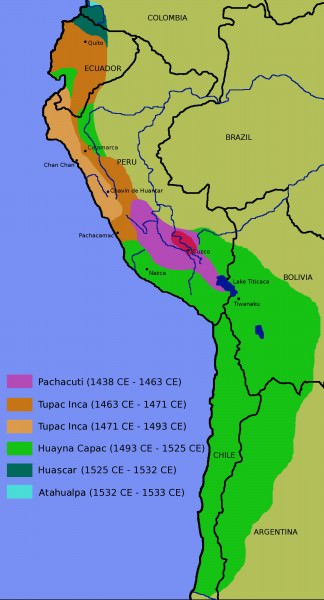
Map of the inca Empire
GOVERNMENT & ADMINISTRATION
The Incas kept lists of their kings ( Sapa Inca ) so that we know of such names as Pachacuti Inca Yupanqui (reign c. 1438-63 CE), Thupa Inca Yupanqui (reign c. 1471-93 CE), and Wayna Qhapaq (the last pre-Hispanic ruler, reign c. 1493-1525 CE). It is possible that two kings ruled at the same time and that queens may have had some significant powers, but the Spanish records are not clear on both points. The Sapa Inca was an absolute ruler, and he lived a life of great opulence. Drinking from gold and silver cups, wearing silver shoes, and living in a palace furnished with the finest textiles, he was pampered to the extreme. He was even looked after following his death, as the Inca mummified their rulers. Stored in the Coricancha templein Cuzco, the mummies ( mallquis ) were, in elaborate ceremonies, regularly brought outside wearing their finest regalia, given offerings of food and drink, and 'consulted' for their opinion on pressing state affairs.
Inca rule was, much like their architecture, based on compartmentalised and interlocking units. At the top was the ruler and ten kindred groups of nobles called panaqa. Next in line came ten more kindred groups, more distantly related to the king and then, a third group of nobles not of Inca blood but made Incas as a privilege. At the bottom of the state apparatus were locally recruited administrators who oversaw settlements and the smallest Andean population unit the ayllu, which was a collection of households, typically of related families who worked an area of land, lived together and provided mutual support in times of need. Each ayllu was governed by a small number of nobles or kurakas, a role which could include women.
Local administrators reported to over 80 regional-level administrators who, in turn, reported to a governor responsible for each quarter of the empire. The four governors reported to the supreme Inca ruler in Cuzco. To ensure loyalty, the heirs of local rulers were also kept as well-kept prisoners at the Inca capital. The most important political, religious, and military roles within the empire were, then, kept in the hands of the Inca elite, called by the Spanish the orejones or 'big ears' because they wore large earspools to indicate their status. To better ensure the control of this elite over their subjects, garrisons dotted the empire, and entirely new administrative centres were built, notably at Tambo Colorado, Huánuco Pampa and Hatun Xauxa.
For tax purposes censuses were taken and populations divided up into groups based on multiples of ten (Inca mathematics was almost identical to the system we use today). As there was no currency in the Inca world, taxes were paid in kind - usually foodstuffs, precious metals, textiles, exotic feathers, dyes, and spondylus shell - but also in labourers who could be shifted about the empire to be used where they were most needed, known as mit'a service. Agricultural land and herds were divided into three parts: production for the state religion and the gods, for the Inca ruler, and for the farmers own use. Local communities were also expected to help build and maintain such imperial projects as the road system which stretched across the empire. To keep track of all these statistics, the Inca used the quipu, a sophisticated assembly of knots and strings which was also highly transportable and could record decimals up to 10,000.
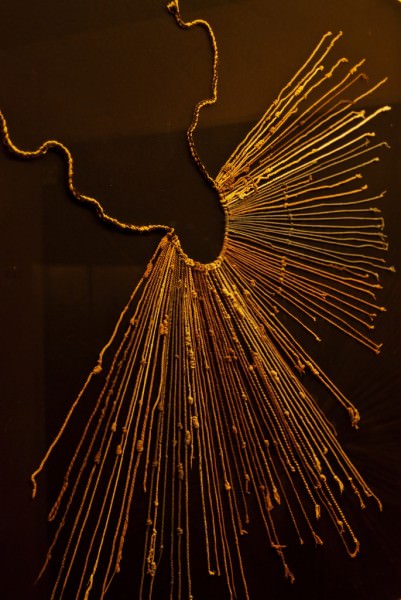
Khipu
MOST SPLENDID WERE THE TEMPLES BUILT IN HONOUR OF INTI AND MAMA KILYA - THE FORMER WAS LINED WITH 700 2KG SHEETS OF BEATEN GOLD.
CUZCO
The Inca capital of Cuzco (from qosqo, meaning 'dried-up lake bed' or perhaps derived from cozco, a particular stone marker in the city ) was the religious and administrative centre of the empire and had a population of up to 150,000 at its peak.Dominated by the sacred gold-covered and emerald-studded Coricancha complex (or Temple of the Sun ), its greatest buildings were credited to Pachacuti. Most splendid were the temples built in honour of Inti and Mama Kilya - the former was lined with 700 2kg sheets of beaten gold, the latter with silver. The whole capital was laid out in the form of a puma (although some scholars dispute this and take the description metaphorically) with the imperial metropolis of Pumachupan forming the tail and the temple complex of Sacsayhuaman (or Saqsawaman) forming the head. Incorporating vast plazas, parklands, shrines, fountains, and canals, the splendour of Inca Cuzco now, unfortunately, survives only in the eye-witness accounts of the first Europeans who marvelled at its architecture and riches.
INCA RELIGION
The Inca had great reverence for two earlier civilizations who had occupied much the same territory - the Wari and Tiwanaku.As we have seen, the sites of Tiwanaku and Lake Titicaca played an important part in Inca creation myths and so were especially revered. Inca rulers made regular pilgrimages to Tiwanaku and the islands of the lake, where two shrines were built to Inti the Sun god and supreme Inca deity, and the moon goddess Mama Kilya. Also in the Coricancha complex at Cuzco, these deities were represented by large precious metal artworks which were attended and worshipped by priests and priestesses led by the second most important person after the king: the High Priest of the Sun ( Willaq Umu ). Thus, the religion of the Inca was preoccupied with controlling the natural world and avoiding such disasters as earthquake, floods, and drought, which inevitably brought about the natural cycle of change, the turning over of time involving death and renewal which the Inca called pachakuti.
Sacred sites were also established, often taking advantage of prominent natural features such as mountain tops, caves, and springs. These huacas could be used to take astronomical observations at specific times of the year. Religious ceremonies took place according to the astronomical calendar, especially the movements of the sun, moon, and Milky Way ( Mayu ).Processions and ceremonies could also be connected to agriculture, especially the planting and harvesting seasons. Along with Titicaca's Island of the Sun, the most sacred Inca site was Pachacamac, a temple city built in honour of the god with the same name, who created humans, plants, and was responsible for earthquakes. A large wooden statue of the god, considered an oracle, brought pilgrims from across the Andes to worship at Pachacamac. Shamans were another important part of Inca religion and were active in every settlement. Cuzco had 475, the most important being the yacarca, the personal advisor to the ruler.
Inca religious rituals also involved ancestor worship as seen through the practice of mummification and making offerings to the gods of food, drink, and precious materials. Sacrifices - both animals and humans, including children - were also made to pacify and honour the gods and ensure the good health of the king. The pouring of libations, either water or chicha beer, was also an important part of Inca religious ceremonies.
The Incas imposed their religion on local populations by building their own temples and sacred sites, and they also commandeered sacred relics from conquered peoples and held them in Cuzco. Stored in the Coricancha, they were perhaps considered hostages which ensured compliance to the Inca view of the world.

Machu Picchu
INCA ARCHITECTURE & ROADS
Master stone masons, the Incas constructed large buildings, walls and fortifications using finely-worked blocks - either regular or polygonal - which fitted together so precisely no mortar was needed. With an emphasis on clean lines, trapezoid shapes, and incorporating natural features into these buildings, they have easily withstood the powerful earthquakes which frequently hit the region. The distinctive sloping trapezoid form and fine masonry of Inca buildings were, besides their obvious aesthetic value, also used as a recognisable symbol of Inca domination throughout the empire.
One of the most common Inca buildings was the ubiquitous one-room storage warehouse the qollqa. Built in stone and well-ventilated, they were either round and stored maize or square for potatoes and tubers. The kallanka was a very large hall used for community gatherings. More modest buildings include the kancha - a group of small single-room and rectangular buildings ( wasi and masma ) with thatched roofs built around a courtyard enclosed by a high wall. The kancha was a typical architectural feature of Inca towns, and the idea was exported to conquered regions. Terracing to maximise land area for agriculture (especially for maize) was another Inca practice, which they exported wherever they went. These terraces often included canals, as the Incas were expert at diverting water, carrying it across great distances, channelling it underground, and creating spectacular outlets and fountains.
Goods were transported across the empire along purpose-built roads using llamas and porters (there were no wheeled vehicles). The Inca road network covered over 40,000 km and as well as allowing for the easy movement of armies, administrators, and trade goods, it was also a very powerful visual symbol of Inca authority over their empire. The roads had rest stations along their way, and there was also a relay system of runners ( chasquis ) who carried messages up to 240 km in a single day from one settlement to another.
INCA ART
Although influenced by the art and techniques of the Chimu civilization, the Incas did create their own distinctive style which was an instantly recognisable symbol of imperial dominance across the empire. Inca art is best seen in highly polished metalwork (in gold - considered the sweat of the sun, silver - considered the tears of the moon, and copper ), ceramics, and textiles, with the last being considered the most prestigious by the Incas themselves. Designs often use geometrical shapes, are technically accomplished, and standardized. The checkerboard stands out as a very popular design. One of the reasons for repeated designs was that pottery and textiles were often produced for the state as a tax, and so artworks were representative of specific communities and their cultural heritage. Just as today coins and stamps reflect a nation's history, so, too, Andean artwork offered recognisable motifs which either represented the specific communities making them or the imposed designs of the ruling Inca class ordering them.
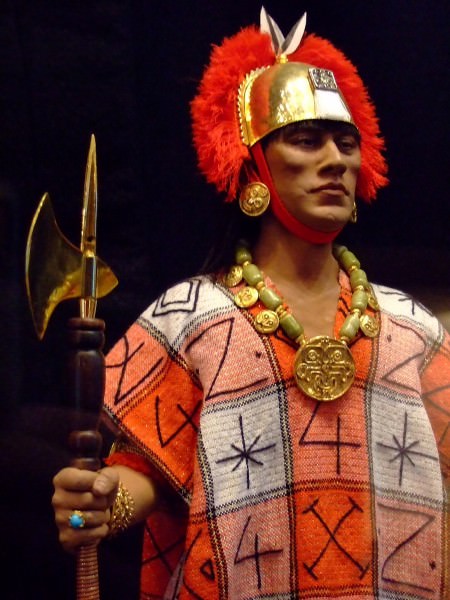
Inca Ruler Atahualpa
Works using precious metals such as discs, jewellery, figures, and everyday objects were made exclusively for Inca nobles, and even some textiles were restricted for their use alone. Goods made using the super-soft vicuña wool were similarly restricted, and only the Inca ruler could own vicuña herds. Ceramics were for wider use, and the most common shape was the urpu, a bulbous vessel with a long neck and two small handles low on the pot which was used for storing maize. It is notable that the pottery decoration, textiles, and architectural sculpture of the Incas did not usually include representations of themselves, their rituals, or such common Andean images as monsters and half-human, half-animal figures.
The Inca produced textiles, ceramics, and metal sculpture technically superior to any previous Andean culture, and this despite stiff competition from such masters of metal work as the expert craftsmen of the Moche civilization. Just as the Inca imposed a political dominance over their conquered subjects, so, too, with art they imposed standard Inca forms and designs, but they did allow local traditions to maintain their preferred colours and proportions. Gifted artists such as those from Chan Chan or the Titicaca area and women particularly skilled at weaving were brought to Cuzco so that they could produce beautiful things for the Inca rulers.
COLLAPSE
The Inca Empire was founded on, and maintained by, force, and the ruling Incas were very often unpopular with their subjects (especially in the northern territories), a situation that the Spanish conquistadores, led by Francisco Pizarro, would take full advantage of in the middle decades of the 16th century CE. The Inca Empire, in fact, had still not reached a stage of consolidated maturity when it faced its greatest challenge. Rebellions were rife, and the Incas were engaged in a war in Ecuador where a second Inca capital had been established at Quito. Even more serious, the Incas were hit by an epidemic of European diseases, such as smallpox, which had spread from central America even faster than the European invaders themselves, and the wave killed a staggering 65-90% of the population. Such a disease killed Wayna Qhapaq in 1528 CE and two of his sons, Waskar and Atahualpa, battled in a damaging civil war for control of the empire just when the European treasure-hunters arrived. It was this combination of factors - a perfect storm of rebellion, disease, and invasion - which brought the downfall of the mighty Inca Empire, the largest and richest ever seen in the Americas.
The Inca language Quechua lives on today and is still spoken by some eight million people. There are also a good number of buildings, artefacts, and written accounts which have survived the ravages of conquerors, looters, and time. These remains are proportionally few to the vast riches which have been lost, but they remain indisputable witnesses to the wealth, ingenuity, and high cultural achievements of this great, but short-lived civilization.
LICENSE:
Article based on information obtained from these sources:with permission from the Website Ancient History Encyclopedia
Content is available under License Creative Commons: Attribution-NonCommercial-ShareAlike 3.0 Unported. CC-BY-NC-SA License